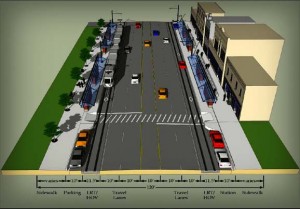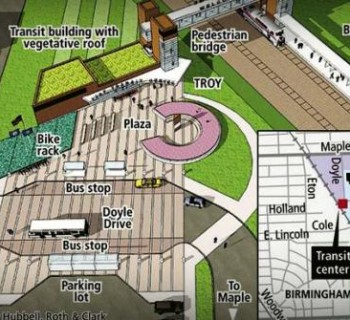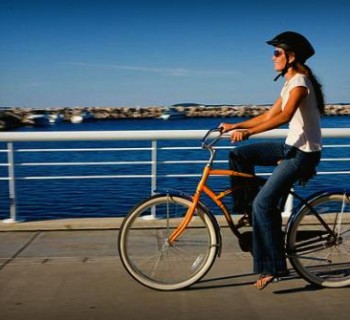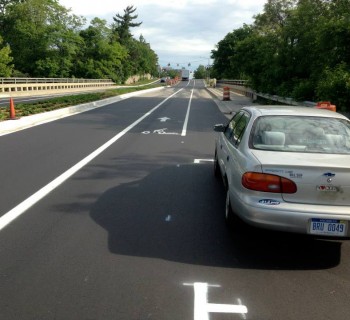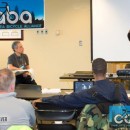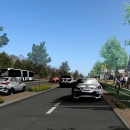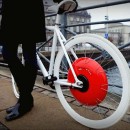DETROIT—There is a general mixture of anticipation and skepticism surrounding the ongoing developments of the Woodward Avenue Streetcar Project. The long awaited first steps forward in a more accessible, better connected regional transit system is certainly cause for public elation. But with the recent updates to the design plans for the M-1 project, the devil is in the details.
Last month, MDOT released a Supplemental Environmental Assessment. The report outlines changes that were made from the initial environmental study done for the 2011 version as the Woodward Light Rail Transit project. This report update was necessary because the crux of the development plan has changed drastically from the WLRT version to the Streetcar plan.
Circulators are primarily for visitors or local users and do not meaningfully add to the development of a more comprehensive day-to-day regional transit system.
We’ve all heard that the scope of the project has shortened dramatically, bringing the end-of-run from 8 Mile all the way back to E. Grand Boulevard. But that’s not all. The center-running Light Rail system has been replaced by a side-running Streetcar system.
Jon Loree, M-1 Project Manager with MDOT, says the Streetcar plan was always the plan for the M-1, dating back to the formation of the planning process in 2007.
The Shortening of the Line: What Does it Mean?
Besides not being able to take the WLRT to the State Fairgrounds to do your Meijer’s shopping, the shortening of the Streetcar system alters the scope of the project from a long-range transit option to a circulator.
Circulators are forms of transit that operate on a predictable fixed route and schedule, and run between a city’s main attractions and most popular neighborhoods. Thus, this type of transit is primarily for visitors or local users and does not meaningfully add to the development of a more comprehensive day-to-day regional transit system.
But Loree says that comparing the M-1 to the ineffectual People Mover is unfounded. He points out that the M-1 will be connecting the People Mover and other locations along its route to the Amtrak station, which aligns with the M-1’s stated purpose to “improve linkages to major activity centers.”
Yet the proposed route doesn’t connect with the Rosa Parks transit center on its downtown loop; the closest it gets is a 4 block walk. This privileges the pool of riders to those that already live and ride along the train route, and brings into question the connections that the M-1 claims to make. Loree says an extension to the downtown loop may be a later addition to the route, but for now the transit center has been cut due to budgetary reasons.
Despite endorsing M-1 as a major step forward in the promotion of regional and local rapid transit in southeast Michigan, the planned future extension of the Woodward line from Grand Boulevard to 8 Mile will simply be a joint stop between a proposed BRT run and the Woodward Streetcar.
Riders arriving on the more efficient BRT from farther neighborhoods have no incentive to switch lines to the slower M-1, which will run at about 11 miles per hour, while the central-dwelling riders of the Woodward Streetcar are discouraged from traveling beyond their prescribed rail path. In other words, this plan is a brilliant means of maintaining Detroit’s status quo of transit inequity while providing the guise of a transit solution to a class of people not entirely dependent on the system.
Why Should You Care About the Switch to Side-Running Streetcars?
The backers of the M-1 are viewing the Streetcar Project as a means of spurring economic development from Downtown to New Center. There has, however, been no study done to assess the economic impacts of such a claim, especially concerning the orientation of the proposed side-running orientation.
Loree claims, however, that Parsons Brinkerhoff, the transportation planning firm consulting on the project, is in fact working off of streetcar precedents in Portland, though he was unsure of what specific studies were used.
Best practices for light rail, streetcars, and BRT unanimously call for center-running lines on two-way streets, and left-running lines along one-way streets. This is both for safety and efficiency reasons. In rare instances, side-running tracks can be used, but they are often used as a last resort or in areas freed of an urban context, such as campuses or suburban locations.
Center-running systems are safer for all user groups. Slower-moving pedestrians (elderly, disabled, children, etc.) looking to cross the wide boulevard can find refuge in the central island between crosswalk lights. While waiting for the train, transit riders are safer because the platform is separated from the congestion of the street, and they are clearly visible at night.
Given the complexity of intersections after the advent of train signals, left turns in a motor vehicle would only be permitted at signaled stops with a center-running system. Since a majority of the vehicle-to-vehicle accidents that occur along Woodward result from attempted left turns, the restructuring of traffic flow to avoid left turns at unsignaled intersections, though less direct than the existing arrangement, will result in a safer outcome for drivers.
One user group that has been left out of planning consideration is cyclists. With the side running scheme it is assumed that cyclists will share the right-most lanes with the streetcar tracks. The parallel arrangement of the tracks to bicycle travel is incredibly dangerous for cyclists because of the likelihood that bike tires will get stuck in the open rails. This is a very serious concern that could lead to many more bicycle accidents and deaths than any other arrangement.
Best practices for bicycles interacting with streetcars calls for center or left-running streetcar lines with bicycle facilities separated from the path of the streetcars. At crossings, the path of bicycle travel should be as close to perpendicular as possible in order to avoid tires from getting caught. The perpendicular arrangement also limits the interaction between vehicle types.
As it stands, the official accommodation for bicycles along Woodward will be no accommodation. In fact, cyclists will be encouraged to divert to alternative routes on either Cass or John R with wayfinding signage that will be installed. This discriminating sentiment runs counter to Detroit’s state-supported Complete Streets initiative, and is regressive of generally accepted international best practices. It is also blindly short sighted, given the plans to destroy the John R surface bridge with the planned I-94 expansion.
Beyond the safety concerns present in the side-running scheme, there are major efficiency issues as well. With the center-running arrangement, trains are given their own right of way and therefore will be faster running and better able to stick to a more regular time schedule.
With the side-running rails, streetcars will be caught up in street traffic with other vehicles. Imagine if a vehicle parks illegally, or if there is an accident, or some other type of slow up. Since the streetcar is limited in its path of travel to its tracks, it would be stuck until whatever blockage has cleared. Since it shares its right-of-way with all other modes of transportation (vehicles, busses, bicycles, etc.) in this arrangement, you can expect there to be frequent delays, leading to unreliable service times.
Using Portland as a precedent, Parsons Brinkerhoff should be aware that there are efficiency concerns with the implementation of the side-running lines. In fact, there is an urban myth in Portland that you can actually walk faster than the streetcar to your destination, which was proven no myth by a local transit reporter.
What are the next steps in the M-1 project?
MDOT closed a public comment period on March 14, during which they received 137 unique comments. These comments are currently being compiled into a document that will be made public in hard copy form at Detroit libraries, MDOT offices, and DDOT offices. The hard copies should be available by the end of the week, and an online version will be up by Monday April 1.
Loree says these comments will be used to assess the current plan. He says many of the comments expressed concern over bike and pedestrian safety, but overall the public shows a lot of enthusiasm and support for the project.
Trains Down The Middle
Check out this video by "TrainsDownTheMidddle" addressing some concerns about the orientation of cars for the M-1 rail.



